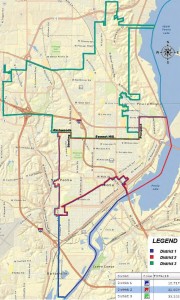On the District 150 school board’s agenda for Monday night, September 12, is a resolution to adopt a new voting district map. Every ten years, elected bodies adjust their representative boundaries to ensure equal representation by population based on the U.S. Census numbers. For District 150, things are a little more complicated because they also have to comply with a 1987 Voting Rights lawsuit settlement agreement.
Before the lawsuit, District 150 board members were all elected at-large. Now the school district has been split into three voting districts. District 1 is deliberately drawn so that it has a “voting age population which will be composed of a majority of minority race voters,” and has one representative. Districts 2 and 3 split up the remaining population and have three representatives each. Here’s how it breaks out:
| District | # of Reps | Mean Voting Age Population |
Actual Proposed Voting Age Population |
Deviation | Black Pop. | Total Minority Pop. |
|---|---|---|---|---|---|---|
| 1 | 1 | 10,951 | 10,717 | -2.1% | 63.47% | 73.60% |
| 2 | 3 | 32,853 | 32,839 | -0.04% | 35.84% | 45.75% |
| 3 | 3 | 32,853 | 33,102 | +0.7579% | 14.18% | 22.83% |
As you can see, it really works out to 10,951 voters per representative (ideally), but rather than split the district into seven districts, they have a goal of one with 10,951 voters and one representative, and two with 32,853 (10,951 x 3) voters and three representatives each. They don’t have to meet the goal perfectly, but they have to be within a 5% deviation of the mean. This proposed map meets that standard.
The data provided by the school district also provides a picture of what we all know but rarely see quantified: the farther north you go, the fewer minorities there are. And remember, this isn’t the entire City of Peoria, just District 150.
Here’s the proposed map:
Hat tip: Emerge Peoria

